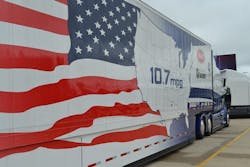OEMs, Cummins disagree on separate GHG engine standard
LONG BEACH, CA. The second public hearing on proposed truck fuel efficiency and greenhouse gas emissions standards shaped up much like the first: Trucking industry representatives expressed qualified support for the stringency goals and implementation schedule outlined by the Environmental Protection Agency (EPA), while air quality regulators and environmental groups called for tougher restrictions and a tighter timeline. And within trucking there is a divide over exactly how the engine and complete vehicle should be measured.
The big four North American heavy-duty truck manufacturers (Daimler Trucks North America, Navistar, Paccar and Volvo Trucks North America) spoke with one voice Tuesday, as Dan Kieffer, director of emissions compliance for Paccar, delivered a statement on behalf of all.
Calling the Phase II rule “historic in its scope and complexity,” Kieffer noted “a long list of technical and protocol issues” the truck makers will work closely with EPA and the National Highway Transportation Safety Administration (NHTSA) to resolve.
“EPA and NHTSA have set very ambitious goals for this industry, and we will do everything we can to ensure that this regulation will translate into significant real world efficiency gains for our customers, as well as major benefits for society,” Kieffer said. "Our goal is a classic 'win-win' scenario, and we are hopeful we can achieve it.”
He also called on the agencies to adopt a “complete vehicle approach” to the regulation, as opposed to separate vehicle and engine standards. The four points of emphasis were:
- Engines are best evaluated based on how they operate in the vehicle, considering the engine size and power output, the vehicle power demand, and the driveline characteristics;
- Truck makers must consider the installation impact of engine-related systems, including space requirements, weight, and cooling demand, all of which can significantly impact the aerodynamic design of the tractor-trailer combination and reduce efficiency.
- NOx emissions are proportional to engine work, so the more effective the vehicle is as a system, the lower the NOx output. But with engine efficiency improvement, there is a well-documented trade-off between NOx reduction and engine efficiency. Therefore, excessive demands for stand-alone engine efficiency would limit the potential for NOx reduction, especially in urban duty cycles where NOx emissions are most critical.
- Businesses that rely on trucks are concerned about the incremental investment and operating costs of complex new engine technology. Putting excessive emphasis on the engine as a stand-alone component can result in costly engine technology that would bring little or no benefit in many real world applications. Unnecessarily stringent engine standards will only exacerbate the trend of delaying new truck purchases, prolonging the use of higher emitting vehicles.
“The fact is that vehicle manufacturers must have the flexibility to optimize the complete vehicle design for maximum efficiency at the lowest cost and complexity,” Kieffer said. “Minimizing total cost of vehicle ownership is a top priority for our customers.”
The truck manufacturers’ opposition to the engine standard goes against support from the world’s largest engine-builder, Cummins Inc.
Fundamental to success
Brian Mormino, executive director of worldwide environmental strategy and compliance, pointed the proposal’s own characterization of a separate engine standard as “fundamental to the success of the program.”
“Cummins wholeheartedly agrees, and as you heard in Chicago and will hear today, so do many others,” Mormino said.
An engine standard offers “a robust, clearly defined compliance program,” requires manufacturers to optimize CO2 and criteria pollutants together, and provides the only measure of engine fuel consumption and CO2 emissions under transient conditions, Cummins contends.
Cummins is concerned, however, that the Phase II proposal’s Greenhouse Gas Emissions Model (GEM) drives more interaction between the engine and vehicle programs. The result is that it requires Cummins to release “proprietary and confidential business information” into the public domain.
Mormino also voiced Cummins’s concerns with “implied engine stringency.”
“It appears additional engine CO2 reduction beyond the explicit engine standards is assumed in the vehicle standards, for example, associated with engine downspeeding,” he said. “Cummins cautions the agencies against this approach.”
“As a result of SuperTruck and our own internal technology development programs, Cummins is confident we have the engine technologies necessary to meet or exceed improvements required by the Phase II engine standards,” Mormino said.
As for common ground for Cummins and the truck makers, all support the 2027 timeframe and call for a single, consistent national program. And that’s where the trucking industry meets the most opposition from regional air quality officials and environmentalists.
Too little, too late
Indeed, the proposal misses “critical opportunities” to reduce greenhouse gas emissions, testified Mary Nichols, chair of the California Air Resources Board (CARB), one of several state and regional regulators and elected officials to speak at the hearing.
CARB called on EPA to adopt Alternative 4 from the proposal, which would accelerate the full program phase-in by three years, from 2027 to 2024. The advanced timetable would accelerate the development of CO2-reducing technologies and deliver emission reductions sooner, Nichols explained.
“In addition, an earlier implementation date will allow for more timely action to pursue a mandatory lower NOx engine standard nationally,” she said. “Addressing NOx from these trucks, which emit a third of our state's NOx emissions, as quickly as possible is absolutely crucial for California to meet our federal ozone attainment obligations.”
CARB also asked for increased stringency, via tighter engine-only standards and consideration of all commercially-viable technology improvements. Citing the SuperTruck program and other research, Nichols suggested the feasibility of engine CO2 reductions in the Phase II timeframe at levels more than twice what EPA is proposing.
And for California, the deployment of low and zero-emission advanced technologies such is the key to achieving climate and air quality goals—and should be a part of the national strategy to meet mid and long-term greenhouse gas reduction targets.
“Unfortunately, the Phase 2 proposal is not sufficiently stringent to drive market development of hybrid, electric, or fuel cell technologies,” Nichols testified. “To actually offset the expected truck activity growth, advanced, near zero emission technologies must be a significant part of the long-term solution.”
As to a 50-state standard, California is “fully committed” to a strong, national program, and will continue to work with EPA and NHTSA to make the rule as effective as possible, the CARB chair noted.
“However, as you know, California is an international leader in developing programs to cut greenhouse gases, while at the same time we face a unique set of air pollution challenges,” Nichols said. “For these reasons, we must always consider the potential for additional California-only program elements as we look ahead.”
EPA is accepting public comments through Sept. 17.
About the Author
Kevin Jones 1
Editor
Kevin has served as editor-in-chief of Trailer/Body Builders magazine since 2017—just the third editor in the magazine’s 60 years. He is also editorial director for Endeavor Business Media’s Commercial Vehicle group, which includes FleetOwner, Bulk Transporter, Refrigerated Transporter, American Trucker, and Fleet Maintenance magazines and websites.

